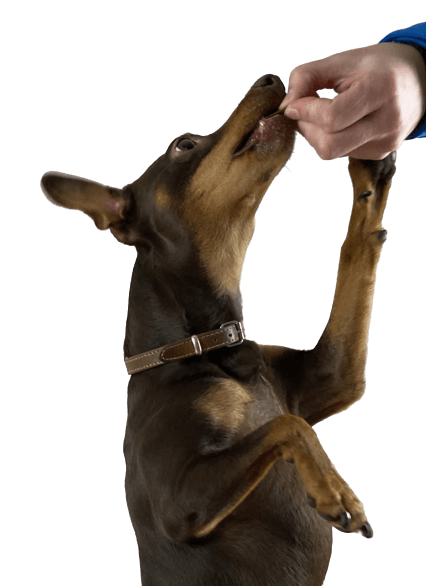Author: Kristof Voet
It can be an everyday conversation between two owners. To roughly predict the reactions of your dog, it is sufficient to know which of the two categories your dog falls into. Do you have a dominant dog? Then it is extremely important that you keep it short from the start and show who is boss. You teach him clear boundaries, and do not allow anything on his own initiative unless you have approved it. Otherwise it threatens to get completely out of hand in the near future.
More than half of the dog schools in Belgium will also guide you according to these principles. For example, it is essential from the very beginning to teach your puppy to walk exactly next to you on the street, and only allow him to sniff when allowed. When he wants to play at a time when he needs to learn, you must also clearly correct him that this is not possible.
And there are plenty of examples to give, because if you don't, he threatens to play with your feet. The urge to become "dominant" within his pack is naturally present in many dogs.
Not only a majority of Belgian dog schools will help you on this path to ultimate obedience, but also many international TV faces known from programs on Discovery Channel and National Geographic, for example, will tell you that obedience and very strict rules where you show the dog who has the last word, are essential to avoid problems.
Many dog behavioural therapists and dog trainers also apply the teachings individually according to the principles of dominance and submission.
But is it also correct? Let's take a look at the origins of the dominance theory, the most well-known and applied behavioural theory regarding domestic dogs.
History of the dog
Based on archaeological information, we find that the domestication of dogs started about 15,000 to 36,000 years ago, in the Eurasian continent. It is unclear whether this happened first in the European part, in the Asian part, or on both continental parts in different places independently of each other simultaneously.
But as such, the dog is the very first animal to be domesticated.
The dog has a distant ancestor in common with the modern wolf, and it is striking that there are still similarities between the two. But the domestication of the dog has had a particularly large influence on its behavior, which is why there are many differences with the wolf.
The ancestor of the dog split off from the wolf very early, possibly as early as 135,000 years ago. A dog skull estimated to be 36,000 years old was found in the cave of Goyet (Belgium), and it clearly differed from wolf skulls of the time; for example, it had a shorter snout, a higher skull and smaller teeth.
Consequences of domestication
The main consequence for us of the domestication of dogs is that they are focused on humans, which is not the case with wolves or the ancestor of the dog that split from the wolf. We have already mentioned some differences in appearance, but otherwise domestic dogs are also becoming more diverse in size, coat and muzzle.
From a physiological point of view, differences occur in the hormonal cycle (for example, wolves are fertile only once a year, most dogs twice) and in the so-called oxytocin system (simply: the happiness hormone).
But in general we can say about dogs that there is no other animal species as diverse with the same DNA as they are, especially in appearance.
A closer look at the changes
We mentioned earlier that an important behavioural change is that dogs are focused on people. This may have been one of the driving forces behind their domestication. In addition, there are some other novelties: dogs bark, which wolves do not. But feeding behaviour also changes for example, from hunters to carrion and waste eaters.
The modern breeds, however, only emerged about 150 to 200 years ago, and were developed based on their working abilities or their beauty.
From a social point of view, dogs live in a family structure. To them, this is a circular structure with no specific ranking, which basically means that dogs don't strive to be in charge. Despite this, dogs are often labelled as “dominant”. How did that happen?
The rise of the dominance theory
This theory originates from research conducted on wolves in captivity. Between 1934 and 1942, observations were made under the direction of biologist Rudolph Schenkel on captive wolves in the Basel zoo. This group of wolves consisted of animals that were randomly placed together when they were not related to each other and in a limited area.
While observing, the researchers were able to determine that there was a constant struggle for power, with the strongest wolves winning and taking their leadership.
They were, as it were, constantly striving for dominance. These observations led Rudolph Schenkel to the creation of the so-called Alpha Theory, a linear authority structure in which you have the strongest breeding wolf at the top of the pack, with the submissive males below, the teenage males and finally the puppies. Parallel to the dominant breeding wolf you will find the dominant breeding female, who in turn stands above the submissive bitches, the teenagers and the puppies.
Based on these findings, biologist and wolf expert David Mech wrote a book in 1968 (The Wolf: Ecology and Behavior of an Endangered Species). His conclusions herein are based on the observations and findings of Rudolph Schenkel. The book became very popular and has been reprinted many times. In the book we find mentions of the term “alpha wolf” and its dominant position. According to Mech, there is a lot of fighting to maintain that position. It is important to know, however, that he made no observations himself for his book and the emergence of the pack model (dominance theory).
Later, however, David Mech himself begins to question his book. During the summers of 1986 to 1998, he will observe wolves in the wild on Canada's Ellesmere Island.
He discovers that there are serious errors in the previous observations and conclusions.
The most important of these are that in the wild wolves form families without strange wolves, and thus no packs. Nor do they fight for the dominant position and they live as a social group, a close family. This involves a great deal of communication in various ways.
“In some cases it will indeed be possible to create the appearance that the training according to the principles of dominance is paying off. Unfortunately, for a dog, this amounts to constant punishment.”
Out with the dominance model
As you read before, the founder of the dominance theory and pack model, David Mech, abandoned his own ideas through sound scientific research. The assumptions behind this pack model were that wolves have a social structure based on linear hierarchy. Then these conclusions were linked to dogs as they descended from wolves. The dominance theory thus teaches us that, as “pack leaders”, we must be on our guard at all times, because dogs will constantly try to dominate us. To prevent this, we need to take preventive measures, by keeping dogs short, or punishing them on time and on the spot so that they know their place in the hierarchy.
So the reasons why this model is wrong are twofold:
- On the one hand, we already mentioned that dogs do not descend from wolves, but from an ancestor that split off from the wolf 135,000 years ago. Since then, there has been an enormous evolution in dogs, which means that they do not have much in common with wolves, then;
- On the other hand, David Mech's pack model relies on Rudolph Schenkel's alpha theory, which stems from erroneous observations on a group of mixed wolves in captivity. This alpha theory or dominance principles do not apply to wolves as well, as in freedom they have a different model of society where there is no linear hierarchy.
Moreover, it remains important to emphasize again that the founder of the dominance theory – David Mech – rejected his own model in the late 20th century.
Why then does the pack model survive?
The main reasons for this can be traced back to “simplicity”:
- You don't need to be educated to understand the dominance principles; it is easy to understand for every human being;
- That's why many people, dog trainers and dog therapists like to apply these principles, including some very famous faces;
- Apparently you can explain a lot of behaviour with it;
- Since it is simple and unambiguous, it seems ideal for solving problems in one, two, three.
So… It does work?
In some cases it will indeed be possible to create the appearance that the training according to the principles of dominance is paying off. Unfortunately, for a dog, this amounts to constant punishment. Not so much physically, but also mentally. Dogs are in fact very complex creatures, with very complicated and sometimes seemingly contradictory communication – ambivalence – and by reducing everything to a few simple principles, we especially risk missing out on a lot. Training or behavioural correction according to the principles of the pack model threatens to cause many side effects that in themselves can lead to behavioural problems in the worse cases. This can be fears, stress, uncertainty, resource guarding, aggression,…
For example, it is not the case that because your dog has learned to walk neatly next to you at the dog school without being allowed to sniff or meet other dogs, and this while you choose the way and not the dog, that he will become happy, stable and balanced. The opposite is true: such dogs often experience a lot of stress and uncertainty. The problem is, unless you are trained in dog communication, you often don't realize this and you think everything is fine with your dog.
So the model doesn't work, because at best it only creates unhappy dogs, but at worst it can lead to serious behavioural problems.
So what exactly is dominance?
Dominance can simply be described as the relationship between two individuals at a particular time over a particular resource. This source can be several things, not just food or water, but also warmth, affection, or toys.
In other words, dominance is a phenomenon of a temporary nature, and may or may not be specific to the character of a particular dog. Of course, some dogs will be more assertive than others, and tough upbringing can drive a dog to be tougher around protecting its resources more often, this still doesn't characterize its own character, just the behaviour on display.
Kristof Voet has been an administrative and logistics employee of Pettherapy.be since 2021. He worked as a volunteer at the animal shelter until 2022, and for this he followed the Asylum Employee training organized by the Flemish Government.





